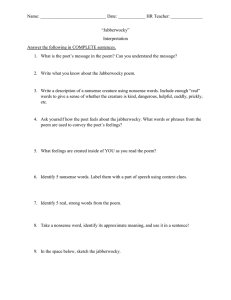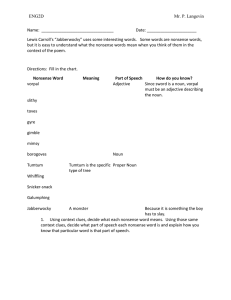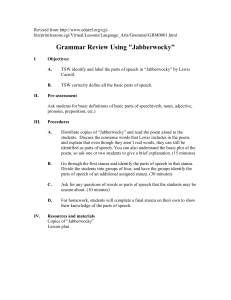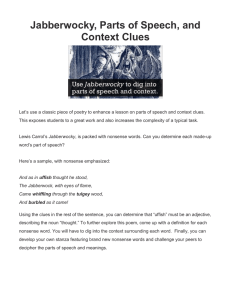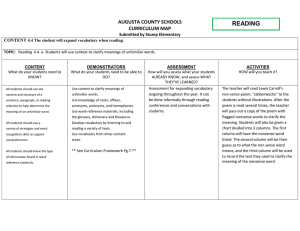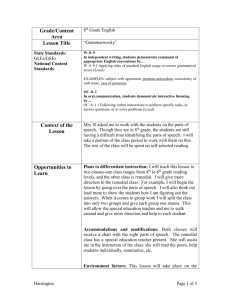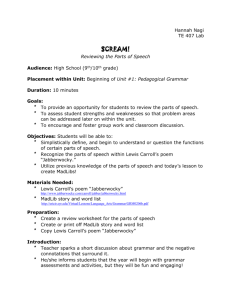Burton Tim Burton 3 December 2010 English Literature "I imagine
advertisement
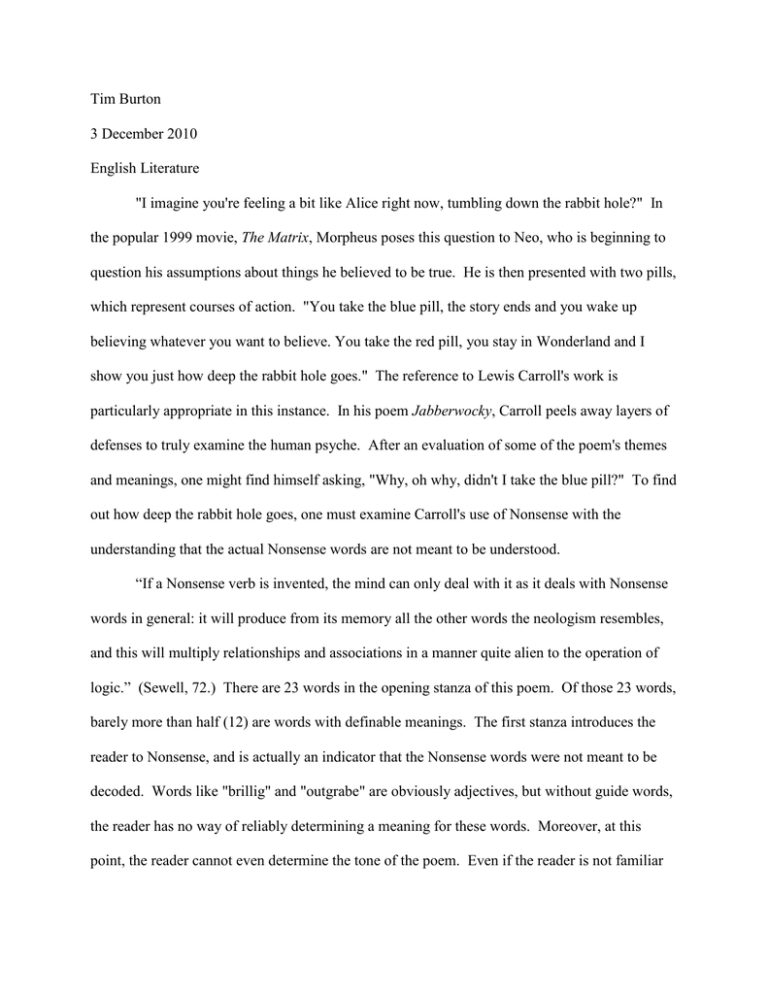
Tim Burton 3 December 2010 English Literature "I imagine you're feeling a bit like Alice right now, tumbling down the rabbit hole?" In the popular 1999 movie, The Matrix, Morpheus poses this question to Neo, who is beginning to question his assumptions about things he believed to be true. He is then presented with two pills, which represent courses of action. "You take the blue pill, the story ends and you wake up believing whatever you want to believe. You take the red pill, you stay in Wonderland and I show you just how deep the rabbit hole goes." The reference to Lewis Carroll's work is particularly appropriate in this instance. In his poem Jabberwocky, Carroll peels away layers of defenses to truly examine the human psyche. After an evaluation of some of the poem's themes and meanings, one might find himself asking, "Why, oh why, didn't I take the blue pill?" To find out how deep the rabbit hole goes, one must examine Carroll's use of Nonsense with the understanding that the actual Nonsense words are not meant to be understood. “If a Nonsense verb is invented, the mind can only deal with it as it deals with Nonsense words in general: it will produce from its memory all the other words the neologism resembles, and this will multiply relationships and associations in a manner quite alien to the operation of logic.” (Sewell, 72.) There are 23 words in the opening stanza of this poem. Of those 23 words, barely more than half (12) are words with definable meanings. The first stanza introduces the reader to Nonsense, and is actually an indicator that the Nonsense words were not meant to be decoded. Words like "brillig" and "outgrabe" are obviously adjectives, but without guide words, the reader has no way of reliably determining a meaning for these words. Moreover, at this point, the reader cannot even determine the tone of the poem. Even if the reader is not familiar Burton 2 with Carroll's admonition that the words are Nonsense, and should be regarded as such, the first stanza dissuades the reader from inferring false meaning. One can determine that the borogoves were in a state of mimsy(ness?) at the onset of the poem, but one cannot determine what this means. The opening stanza creates confusion purposefully. When Alice steps through the looking-glass, many things are backwards and confusing. However, her emotions and feelings remain intact. The reader is meant to understand that looking-glass land is a venue for exploring the persona of the protagonist. In Jabberwocky, the same holds true. The second stanza is the red pill of the poem; when one explores it, Nonsense and reality collide to lay bare human emotion. While the reader does not know what the Jabberwocky, or the Jubjub bird, or even the Bandersnatch is, the reader acutely understands the word "[b]eware," and knows to stay away from "jaws that bite" and "claws that catch." Moreover, the Nonsense words are now associated with a tone. "[F]rumious" is not in the dictionary, but the reader can infer that the word carries with it a connotation of fear and warning. A translation of the Nonsense words is unnecessary. The narrator tells the reader that the Jabberwocky is something to be feared, and it is here that the Nonsense words take on a meaning that transcends definition. The Jabberwocky, while corporeal in the poem, is actually an abstract idea; the Jabberwocky is a trial of courage. It is appropriate that the poem's hero is a youth (as evidenced by the paternal advice in the second stanza.) Paying no heed to his father's warning, the youth actually goes out in search of his "manxome foe." He is prepared for the battle physically; he took his "vorpal sword" with him. However, the youth is not fully prepared to meet his trial mentally; he "stood awhile in thought." As trials often do, the Jabberwocky comes upon the youth unexpectedly "as in uffish thought he stood." Once again, a definition of the Nonsense words is unnecessary. The reader Burton 3 does not know what makes thought "uffish," nor exactly what requirements have been met to make the youth's sword "vorpal." The reader can however, understand the connotations implied by the urgency of the diction, as well as the violence of the seemingly onomatopoetic "snickersnack." Halfway through the fifth stanza, the Nonsense becomes a tool to convey meaning. The youth successfully slays the Jabberwocky, metaphorically conquering his fears and mastering his trial of courage. Taking the Jabberwocky's head as a trophy, "he went galumphing back." Again, the reader is not meant to understand the meaning of the word "galumphing," only understand its connotation. The word itself sounds joyously victorious, and gives the reader a chance to identify with the triumphant youth on a deeply personal level. The youth's father shouts further joyous nonsense: "O frabjous day! Callooh! Callay!" In this outburst it is not only impossible to define the words, it is important that the reader chooses not to define them. The connotation, the feeling of victory obtained through courage, is infinitely more important than a single, well-defined narrative. Herein lies the timeliness of Jabberwocky, and the reason it is so well known and loved more than a century after it was first penned. The poem itself bypasses a defined narrative entirely, and focuses solely on meaning. The reader identifies with trials, enemies, and fatherly advice. The reader knows that their own problems are formidable. The beauty of Jabberwocky lies in a message that these trials can be overcome, provided your sword is vorpal, with a little ingenuity and courage. Contrariwise, there are those who claim that the poem is an exercise in portmanteau; a clever combination of words that give the otherwise average poem a unique and catchy voice. Certain unnamed students who use Wikipedia to analyze their poems for them and hold that the word "slithy" is a combination of the words "slimy" and "lithe," are taking the blue Burton 4 pill. They wake up, believing whatever they want to believe, blissfully ignorant of the poem's rich message. Jabberwocky uses Nonsense to bypass words altogether. The poem instead portrays feelings and connotations; messages with which even the smallest child can identify. It is for this reason that Carroll is considered one of the masters: Jabberwocky gives a deep and wonderful meaning without using complex language. All one needs to understand the human condition is a little Nonsense.
